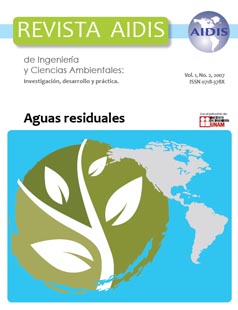Reator UASB tratando esgoto sanitário e digerindo lodo aeróbio excedente
Main Article Content
Abstract
This paper discusses the performance of an upflow anaerobic sludge blanket reactor (UASB) treating sanitary wastewater and digesting excess sludge from an aerobic activated sludge unit. The research equipment consisted of two UASB reactors, both of plastic material reinforced with fiberglass, 407 liters each, and a post‐treatment system – an activated sludge unit. They were located at the Technological Hydraulics Center of the University of São Paulo. This experiment was run in three different phases: (1) Start‐up of the UASB 1 and of the UASB 2 (day 0 to day 194), (2) Normal operation of the UASB 1 and of the UASB 2 (day 195 to day 412); and (3) Return of the excess secondary sludge from the activated sludge unit to the UASB 2 (day 413 to day 527). The wastewater flow was 50 L/h, HDT 8 hours, and the average flow of the return aerobic excess sludge was 24 L/d. The following average concentrations were measured for the effluent of UASB 2 in the Phase 3: 198 ‐ 158 mg/L (Total COD), 46 ‐ 18 mg/L (Total BOD), 48 ‐ 19 mg/L (TSS). In the same period, with the same flow, and the same HDT, UASB 1 presented the following effluent average concentrations: 234 ‐ 157 mg/L (Total COD), 67 ‐ 1 mg/L (Total BOD), 72 ‐ 67 mg/L (TSS). According to such results, it can be concluded that UASB 2 was efficient to reduce the incoming organic matter, and maintained the treatment efficiency, its performance not being negatively affected when the excess aerobic secondary sludge was diverted to the UASB reactor.
Article Details
How to Cite
[1]
Hélia Caseiro, A., Passos Piveli, R. and Alem Sobrinho, P. 2009. Reator UASB tratando esgoto sanitário e digerindo lodo aeróbio excedente. Revista AIDIS de ingeniería y ciencias ambientales: Investigación, desarrollo y práctica. 1, 2 (Nov. 2009).


